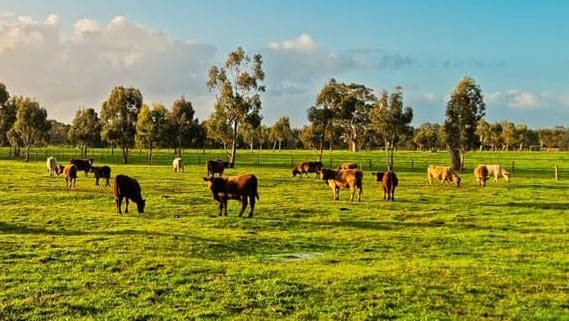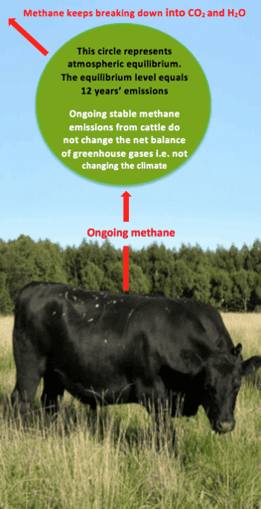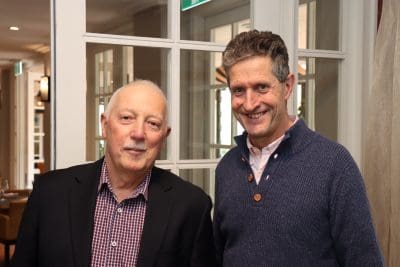OPINION

THE way Meat and Livestock Australia (MLA) and the Australian Government are approaching cattle methane, is not the way scientists say methane should be treated. Decisions are being made that don’t align with how the natural world functions.
Until now, no Ag organisation from NFF down has taken the time to investigate the science that MLA relies on. There is an old saying that when everybody thinks alike, nobody is thinking very much.
At a recent presentation in Canberra, Professor Myles Allen of Oxford University emphasised that the GWP100 metric (which CN30 relies on) calibrates all greenhouse gases as CO2 equivalents, and this produces incorrect results when it comes to methane. Myles said, “The problem is we have widespread misunderstanding and confusion about how methane influences global climate. A lot of this is summed up in this notion of CO2 equivalence, or the carbon footprint which I’m sure many of you will be familiar with, which pretends methane is a kind of CO2, and it isn’t. We have an opportunity to refocus climate policy on warming outcomes rather than emissions inputs. This might make climate policy more effective”.
Professor Allen led a team that developed the GWP* metric, which more accurately quantifies the warming effect of short-term greenhouse gases like methane.
Here is an example which highlights that GWP100 is not a good measure of temperature change, when it comes to short term gases like methane. GWP100 says that a reduction in ongoing stable methane emissions from cattle will still result in temperature rise, when this action actually produces global cooling.
It is true that methane is a very strong greenhouse gas and much stronger than CO2, however, we need to understand how methane behaves in the atmosphere before we can fully understand its influence on temperature change (climate change).
I will now explain how methane behaves in the atmosphere, which is totally different to CO2 that is a long-lasting gas.
How methane behaves in the atmosphere

Methane lasts 12 years in the atmosphere, before being broken down into CO2 and H2O. It is broken down by a chemical reaction with hydroxyl radicals (OH) that keep forming in the atmosphere. It is true that cows are constantly releasing methane into the atmosphere, however, while a cow is releasing methane today, the methane emissions 12 years ago will be breaking down in the atmosphere at the same rate. Providing extra cows are not put in the paddock, the methane residing in the atmosphere will stay in equilibrium, with the additions and subtractions.
The green circle could represent a paddock, a property or a country.
The purpose of the above diagram is to highlight that with each cow in the paddock, the ongoing release of methane every day, is not changing the amount of methane residing in the atmosphere. This is because methane is a short-term gas that keeps breaking down. You can keep replacing a cow in the paddock with a new one for a hundred years, and the amount of methane residing in the atmosphere will not change.
 It is an increase in cattle numbers that increases the amount of methane in the atmosphere. Australian cattle numbers have remained stable since the mid 1970’s, so methane releases from the Australian cattle herd have not been changing temperature (the climate) for a long time. However, lobby groups keep calling for the Australian cattle herd to be halved to save the planet.
It is an increase in cattle numbers that increases the amount of methane in the atmosphere. Australian cattle numbers have remained stable since the mid 1970’s, so methane releases from the Australian cattle herd have not been changing temperature (the climate) for a long time. However, lobby groups keep calling for the Australian cattle herd to be halved to save the planet.
You can’t blame the average person in the street for thinking that cattle are a problem.
The organisations representing cattle producers have not been promoting the correct science to counter misinformation.
By promoting CN30, MLA reinforces the message that methane from Australian cattle is changing the climate on a yearly basis. It would be a lot smarter to promote the message of equilibrium that the cow and circle diagram conveys, and then say that the industry is focused on reducing existing methane emissions, which will result in global cooling. People need to understand that cutting the existing stable methane emissions, will have the same effect on temperature as planting trees.
This question needs to be put to the general public and Government. If Australian cattle are not increasing the level of methane in the atmosphere, then how can the methane they are producing be changing the climate? Asking questions, instead of lecturing, is one way of getting people to think.
The conclusions in the diagram above only apply to agricultural emissions. Fossil methane (CH4) emissions are putting “New” CO2 into the atmosphere when the CH4 breaks down.
What the CN30 commitment really means
The CN30 commitment means that methane emissions from Australian cattle have to be reduced to zero OR offset by tree growth, increased soil carbon or purchasing carbon credits.
CO2 and N2O (nitrous oxide) also have to be reduced to zero. However, the methane aspect is the main issue, given it is such a high percentage of the beef industry emissions.
To put CN30 into perspective, if the green circle in the diagram represents Australia, then it has to be reduced to zero. Remember, the green circle represents not changing global temperature and any reduction produces global cooling. MLA has committed the cattle industry to producing global cooling, when no other industry has been asked to do this.
Whichever way you look at it, meeting CN30 will cost the cattle industry untold billions of dollars and deprive Australia of export income. CN30 is like the Titanic lining up an iceberg.
Climate Neutral is exactly what the words say, not changing the climate
Climate Neutral is managing emissions to achieve no more warming. The goal is no more warming, not ending food production, job creation, and economic activity.
Climate Neutral is not some new fad. Climate Neutral is based on IPCC science and aligns with the climate stabilisation goal of the Paris Agreement.
The Paris Agreement in 2015 states its goal is, “To limit global warming to well below 2, preferably to 1.5 degrees Celsius, compared to pre-industrial levels. To achieve this long-term temperature goal, countries aim to reach global peaking of greenhouse gas emissions as soon as possible to achieve a climate neutral world by mid-century.”
MLA is very aware that CN30 can’t be achieved and so is the scientific community. MLA needs to change the target from carbon neutral to climate neutral. The report, “Pathways to climate neutrality for the Australian red meat industry”, produced by CSIRO scientist Dr Brad Ridoutt in March 2023, provides MLA the opportunity to change to Climate Neutral.
Dr Ridoutt’s report states in part:
“Climate Neutral should not be considered as a lesser target compared to Carbon Neutral.
The pasture-based beef cattle and sheep for meat sectors are both projected to individually achieve climate neutrality in 2026. The feedlot sector is projected to achieve climate neutrality two years later in 2028.
The adoption of Climate Neutrality as a standard by the industry would provide greater scope for the industry to grow and contribute to global food supplies.”
In this report, Dr Ridoutt used the GWP* metric to calculate when it should be possible to achieve Climate Neutrality.

Alan Lauder and Professor Myles Allen in Canberra in July.
Recently in Canberra, Cattle Australia held a forum where Professor Myles Allen, one of the world’s top physicists, explained that the GWP100 metric is misrepresenting the warming effect of cattle methane.
In a recent Beef Central article, Luke Bowen, the CEO of Cattle Australia said, “Climate neutrality offers a great opportunity for the Australian red meat sector to be able to stand up and say it is no longer contributing to global warming. This could be as early as 2026.
Mr Bowen said Cattle Australia has begun formal engagement with MLA.”
For those producers who have had stable methane emissions for some time, reducing these methane emissions would help offset CO2 emissions and N2O emissions, on the path to being climate neutral.
With Climate Neutral, you are reporting your impact on temperature. Nothing could be more transparent.
MLA knew in 2012 that GWP100 was misrepresenting methane
Nobody was more shocked than me when MLA committed the red meat industry to CN30 in 2017.
In 2012, MLA was fully aware that the GWP100 metric was incorrect when it came to the warming effect of cattle methane.
Back in 2010, with the help of a CRC scientist, I came up with the “Lauder Calculator”, a new approach to methane. In 2012, a former employee of MLA approached MLA to fund some of Australia’s top atmospheric scientists to fly to Brisbane and meet with me to fully understand what I was proposing.
This meeting led to the peer reviewed paper “Offsetting methane emissions – An alternative to emission equivalence metrics”, that was published in the International Journal of Greenhouse Gas Control.
The very first line in the “Abstract” of the paper states, “It is widely recognised that defining trade-offs between greenhouse gas emissions using “emission equivalence” based on global warming potentials (GWPs) referenced to carbon dioxide produces anomalous results when applied to methane.”
In the “Acknowledgements” on page 9 of the paper is written, “The approach in this paper was developed at a workshop funded by Meat and Livestock Australia (MLA). MLA also provided funding for open access publication.”
I have always felt sorry for the cattle industry. MLA knew the truth when they committed to CN30 and looked the other way.
In the middle of the Abstract, is a line that meshes in with GWP*, “We argue that a more appropriate way to consider the relationship between the warming effects of methane and carbon dioxide, is to define a “mixed metric” that compares ongoing methane emissions (or reductions) to one-off emissions (or reductions) of carbon dioxide”.
The above sentence enables this statement. Given CO2 accumulates, while methane does not, then, if methane emissions from cattle are kept stable, this is the same as cutting CO2 emissions to zero. This is an example of how the cattle industry could be communicating to the broader community.
Change is starting to happen
Last year, the Hughes Pastoral Group, who are one of Australia’s largest cattle producers, running 200,000 cattle, announced that their goal is to be Climate Neutral.
The newly formed Cattle Australia is working on how best to counter misinformation being spread about cattle methane. The cattle industry, including processors, need to fall in behind Cattle Australia to ensure the narrative is changed before it is too late.
And finally, a message for consumers who are focused on guilt free food – Australian beef is guilt free.
- Farmer and author Alan Lauder ran sheep and cattle in South West Queensland for more than 30 years. His deep level of interest in how livestock and plants interact with the carbon cycle led to the publication of the ‘Carbon Grazing’ principle in 2008 and a 2012 paper with several climate scientists which pre-figured the GWP* climate metric developed by Oxford University’s Dr Myles Allen and his team in 2018.
